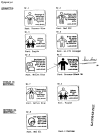The evolution of health warning labels on cigarette packs: the role of precedents, and tobacco industry strategies to block diffusion
- PMID: 23092884
- PMCID: PMC3725195
- DOI: 10.1136/tobaccocontrol-2012-050541
The evolution of health warning labels on cigarette packs: the role of precedents, and tobacco industry strategies to block diffusion
Abstract
Objective: To analyse the evolution and diffusion of health warnings on cigarette packs around the world, including tobacco industry attempts to block this diffusion.
Methods: We analysed tobacco industry documents and public sources to construct a database on the global evolution and diffusion of health warning labels from 1966 to 2012, and also analysed industry strategies.
Results: Health warning labels, especially labels with graphic elements, threaten the tobacco industry because they are a low-cost, effective measure to reduce smoking. Multinational tobacco companies did not object to voluntary innocuous warnings with ambiguous health messages, in part because they saw them as offering protection from lawsuits and local packaging regulations. The companies worked systematically at the international level to block or weaken warnings once stronger more specific warnings began to appear in the 1970s. Since 1985 in Iceland, the tobacco industry has been aware of the effectiveness of graphic health warning labels (GWHL). The industry launched an all-out attack in the early 1990s to prevent GHWLs, and was successful in delaying GHWLs internationally for nearly 10 years.
Conclusions: Beginning in 2005, as a result of the World Health Organisation Framework Convention on Tobacco Control (FCTC), GHWLs began to spread. Effective implementation of FCTC labelling provisions has stimulated diffusion of strong health warning labels despite industry opposition.
Keywords: Advertising and Promotion; Advocacy; Packaging and Labelling; Tobacco industry; Tobacco industry documents.
Conflict of interest statement
Figures





References
-
- Studlar DT. Tobacco control: comparative politics in the United States and Canada. Ontario: Broadview Press; 2002.
-
- Cairney P, Studlar DT, Mamudu H. Global tobacco control: power, policy, governance and transfer. Vol. 23. Basingstoke, Hampshire, England: Palgrave Macmillan; 2012. pp. S117–29.
-
- Blondal P, Hardarson P, Helgason T, et al. (Tobacco or living? decrease in smoking in Iceland 1985–1990) Nord Med. 1991;106:11–12. - PubMed
Publication types
MeSH terms
Grants and funding
LinkOut - more resources
Full Text Sources
Medical
